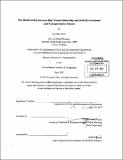The relationship between rail transit ridership and built environment and transportation system
Author(s)
Chen, Szu-han
DownloadFull printable version (13.12Mb)
Other Contributors
Massachusetts Institute of Technology. Department of Civil and Environmental Engineering.
Advisor
P. Christopher Zegras.
Terms of use
Metadata
Show full item recordAbstract
Public transportation is an effective tool to tackle many urban transportation problems. Due to its higher capacity and reliability, rail transit often serves as the main means to connect major trip origins and destinations in a metropolitan area. We have witnessed that rail transit systems continue to be built or extended in cities around the world, including the cities in the U.S. As transit supply increases, planning concepts such as Transit-Oriented Development (TOD) seek to integrate urban environment with transit systems in order to promote transit use. Traditionally it is thought that people's travel behavior is shaped by travel time or monetary costs only, but the emergence of many recent studies suggests that the built environment also plays a role in people's travel decisions. This research examines the relationship between rail transit station ridership and the factors categorized into three groups: transportation system, built environment, and socio-demographics. The stations of Boston's rail transit system are analyzed. The method used is the direct demand approach with OLS regression. Bootstrapping and spatial regression are also used as enhanced models. Variables concerning each station as well as the station catchment area were considered and tested. This research finds that factors related to transportation system, land use, pedestrian environment, and socio-demographics are important. Different combinations of predictors are found during different time periods, reflecting the temporal difference in travel patterns. The findings of this research are in line with the TOD concept that certain elements of the built environment, such as higher levels of employment and population in the station area, and a more walkable environment, are associated with increased transit ridership. The results could lend support to future transit line planning, the design of neighborhood road networks, and land use policy-making.
Description
Thesis (S.M. in Transportation)--Massachusetts Institute of Technology, Department of Civil and Environmental Engineering, 2013. Cataloged from PDF version of thesis. Includes bibliographical references (pages 145-149).
Date issued
2013Department
Massachusetts Institute of Technology. Department of Civil and Environmental EngineeringPublisher
Massachusetts Institute of Technology
Keywords
Civil and Environmental Engineering.